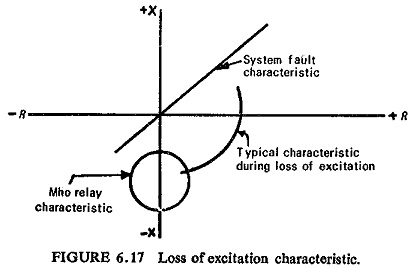Loss of Excitation Protection:
Two distinct effects of Loss of Excitation Protection are that the machine starts drawing magnetizing current of large magnitude from the system, and the slip frequency emfs induced in the rotor circuit; both of them cause overheating of the rotor.
Loss of Excitation Protection can be detected by measuring the reactive component of stator current; an excessive value of VAR import indicates either actual or prospective loss of synchronism. To allow for system transients which may cause a momentary reversal of VAR component it is usual to incorporate a fixed time delay of between one and five seconds in the tripping sequence of the relay.
It can also be detected by an undercurrent moving coil relay in the field circuit, but some large generators operate over a very wide range of field excitation and such a relay may be an embarrassment. Furthermore, field failure due to exciter failure may not be detected because the undercurrent relay may be held in by a.c. induced from the stator.
An undercurrent relay fast enough to drop out on a.c. cannot be used because it would be affected by a.c. induced during synchronizing and during external faults.
An alternative solution is to apply an offset impedance or mho measuring relay at the generator terminals. Its operating characteristic is arranged as shown in Fig. (6.17) so that during conditions of extremely low excitation or complete loss of excitation the equivalent generator impedance falls within the tripping zone.
